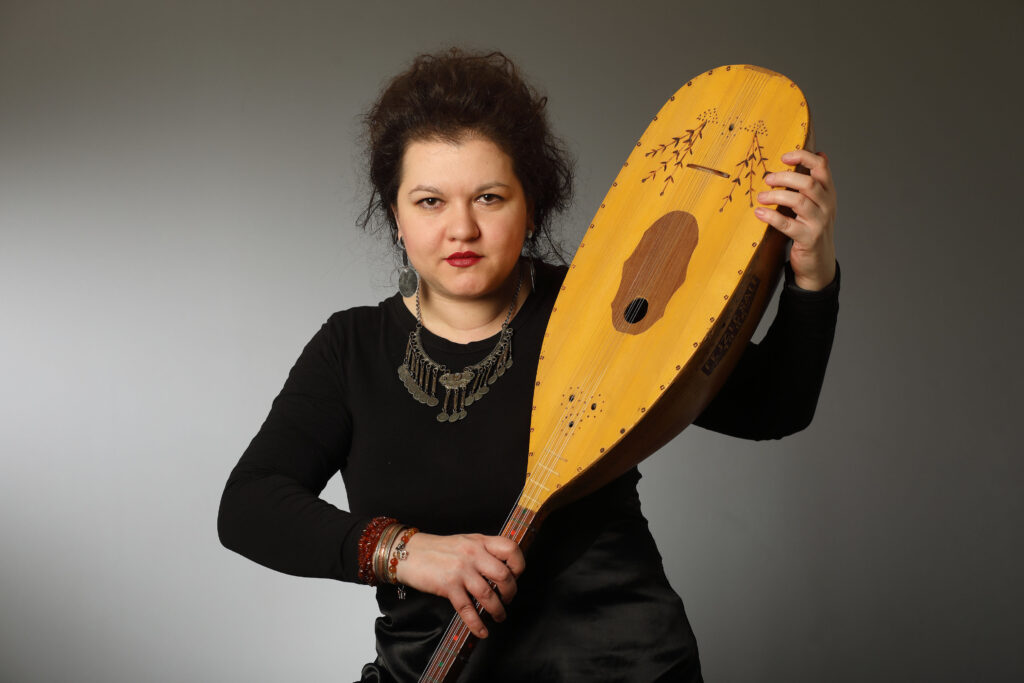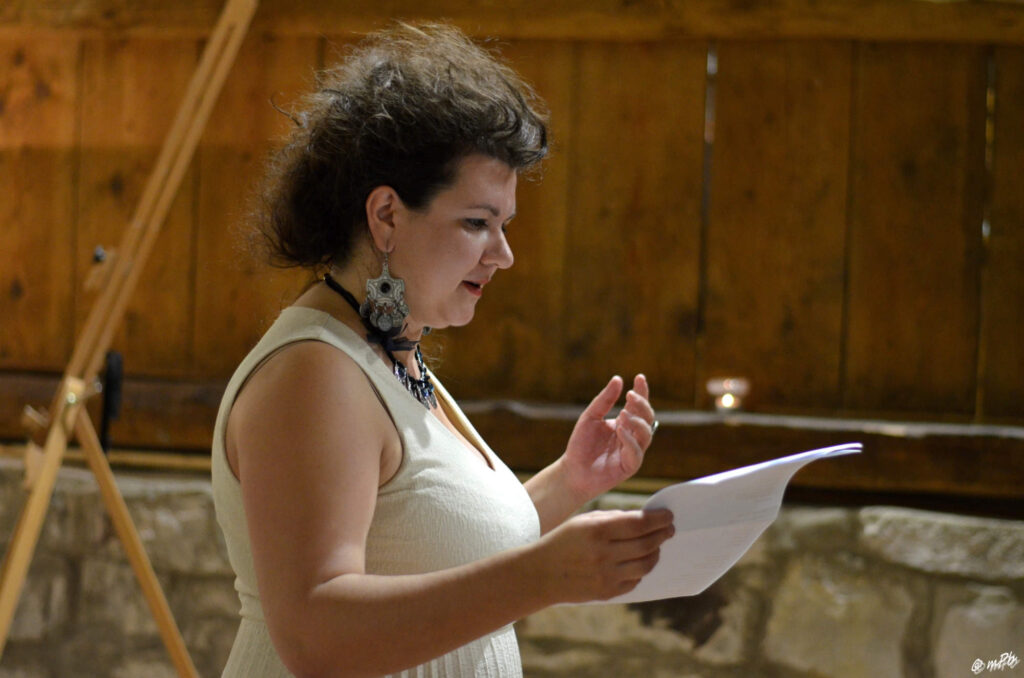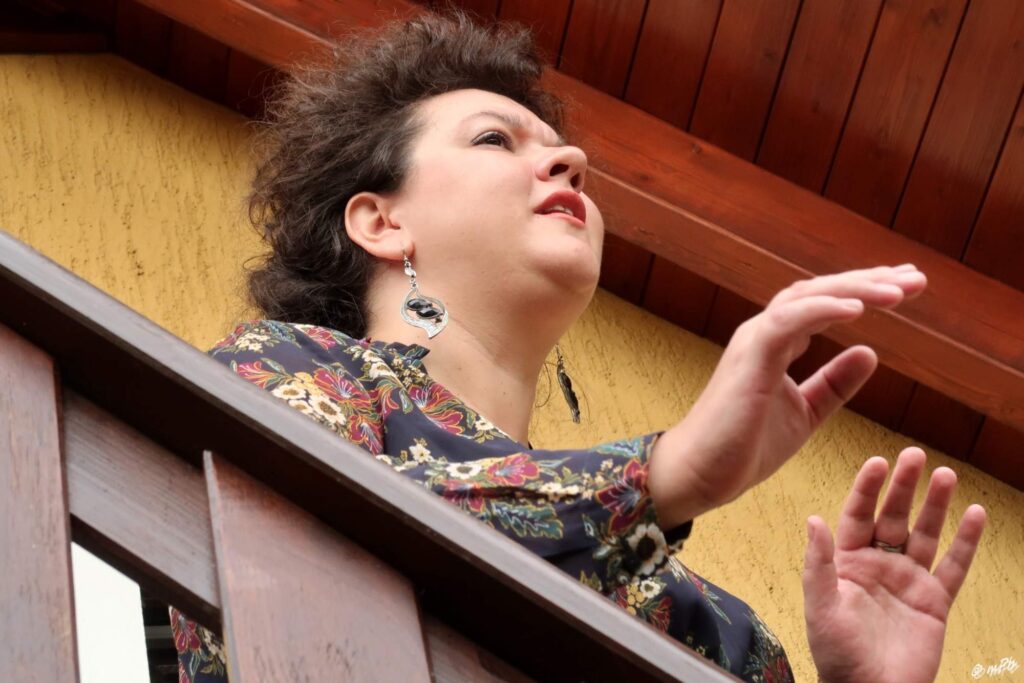Singer and pianist Aida Mujačič was born in the city of Tuzla in former Yugoslavia. As a child, she had experienced the war in Bosnia and Herzegovina during the 1990s. At present she lives in Prague, committing herself to the promotion of Bosnian folk songs, including Jewish tunes sung in the Ladino language (medieval Spanish), which had been collected by the Czech ethnographer and painter Ludvík Kuba in the Balkans during the 1890s. Aida Mujačič was also captivated by the works of the wartime Terezín inmate Karel Reiner (1910 – 1979) whose music she incorporated into her program called Reiner(carnation). She also gave several performances at the award-giving ceremonies of the Hana Greenfield Memorial – the Terezín Memorial´s literary and art competition.
What do you find so captivating in the personality of composer Karel Reiner?
I was introduced to the personality and works of Karel Reiner by Pavel Straka of the Department of Education of the Terezín Memorial who had not only drawn my attention to Reiner´s works and life on the occasion of the 110th anniversary of his birth (commemorated in 2020); Pavel Straka also had a lion´s share in compiling the dramaturgy for the above-mentioned program.
As I am interested in an aesthetic which is both refined and extraordinary and which does not succumb to school conventions, this project was immediately a great allurement for me. Moreover, Reiner´s life displayed certain parallels with my own life: as an educator and music composer, Karel Reiner was forced to stay in the basements (real and imaginary) of the Terezín Ghetto and even before the transport to that place, during the persecution of Jewish citizens, he tried his best to show the captive children – despite the cruelty of Nazism – beauty and love. I myself had to have my lessons of classical piano in a cellar in my native city of Tuzla in the territory of Bosnia and Herzegovina during the first half of the 1990s. Resolved to brighten up my life under Tuzla´s orange-hued sky colored by gunpowder, amidst the sounds of war sirens, machine gun shooting and honking ambulances, my parents came up with an offer of the music of Viennese salons and Bach´s Picardy thirds. Those always lead up to happy endings. And that is the parallel of my life with that of Karel Reiner who looked for a ray of light at the end of the tunnel of the horrifying stories of not only his own life but also the lives of Terezín children, while stressing that humanity always prevails over justice.
But your interpretation of the composer´s music is not always what you might call literal.
Yes. I proceed from the fact that the melodies for the Terezín performance of Esther were not based on any preserved and precise musical notation; that had been lost at the end of the war. We know how the songs in the play really sounded only thanks to the actors who had actually appeared in its performance and survived the Holocaust. As a result, they were in a position to provide relevant information to the musicologists who, assisted by the memory of the survivors, were restoring musical notation for the play in the 1990s. Moreover, the precise musical notation is a relatively new project, of which I, as a former student of musical science, am well aware. In fact, I also applied the method of variations and reincarnation of Reiner´s music to his songs composed during the late 1930s (Three Love Songs, November Ditties) and primarily to the cycle Flowery Horse. Its central melody was an invitation for me to combine the melodic inspired by Moravia (the native region of Reiner´s teacher Alois Hába who was also inspired by Moravian melodies) with the Balkan melodic associated with my home country. At the same time, my approach is definitely not academic. My piano playing and my adaptations of songs aspire to give prominence to the kind of love and my own truth that sometimes pose slightly irritating, even “nagging” questions, whose urgency is accentuated by the present times and whose impact is limited by the sounds of a tempered piano.
To date, you have performed at three award-giving ceremonies of the Terezín Memorial´s art competitions (on two occasions in the Ghetto Museum cinema, once in the attic theater in the Magdeburg Barracks); you also sang at a preview of the photographic exhibition by Miroslav Vavřín, held in the lobby of the Small Fortress cinema. How do you perceive the genius loci of this place?
I visited Terezín five times altogether. In addition to the above-mentioned performances, I also gave a seminar for students of a Pilsen high school, sharing my experience and memories of the war in Bosnia. For me, the weight of the history of the place is enormous and not only because Bosnians had also been imprisoned in Terezín in the past (Hadji Lojo, leader of the uprising against Austrian occupation, the six assassins from 1914) and some of them died here. It seemed to me I could neither speak nor sing when seeing the WWII prison cells and the graves in the local cemeteries that evoked the suffering common to all mankind, and the evil some politicians and soldiers cause, time and again, through their rhetoric and actions.
It happened like this: some time in 2021 I saw an old linden tree in the Small Fortress, and the tree seemed to reflect everything that had transpired in those places more than 70 years ago; the linden tree is still standing, bare and exposed to rain, wind and sun. It reminded me of how to rejuvenate mortality, and immediately afterwards I realized that we die once but live every day. “While I breathe, I hope!” A year later, during the award-giving ceremony to the winners of children´s competitions in the Ghetto Museum cinema I saw a movie called Imprisoned Dreams which confirmed my hypothesis; but that is valid only as long as we manage to retain in adult age the dignity and courage of seeing the world through children´s eyes.
Could you describe in greater detail your method of interpreting music by Karel Reiner?
Being a trained pianist, my voice, therefore, lies in my hands, in the strings and the piano keyboard. A perfectly tuned piano cannot exist in a war, and – strictly speaking – anywhere outside the best concert halls either. But an out-of-tune piano also has its own sound that emanates beauty. In Terezín as well as in the cellars in Tuzla or in beleaguered Leningrad, the prime purpose of playing the piano was by no means a quest for imaginary or formal perfection, but simply to play and chiefly to know why to play. It was an existential necessity, with no aestheticism involved. That is why I put a band across the keyboard of my piano, thus turning it into an instrument harking back to those wartime horrors in the basements; the piano may also serve as a dulcimer, an instrument played by musicians inspired by Central European folk music (as encountered not only in the music of Karel Reiner, but also of Leoš Janáček, Béla Bartók, Emil František Burian, Alois Hába), which returned to classical music the rawness of sexuality and everyday life. At the same time, I try to play with maximum energy which was the hallmark of Romantic and Impressionist composers or Dmitri Shostakovich in the 20th century. I grew up with this kind of music both as an interpreting artist and a music lover.
However, I also combine Reiner´s work with songs of amorous yearning coming from the Balkans, known as Sevdalinka or Sevdah music. Such tunes were also collected by the Czech ethnographer and painter Ludvík Kuba in Bosnia in the 1890s. I devote myself to this kind of music also as a singer. Other Balkan love songs known from Kuba´s collections are romances of Sephardic Jews in Ladino (medieval Spanish). I am in search of undercurrents interlinking different musical genres, and I am convinced that in this case the interconnection is more than obvious.
What kind of message do you want to express through your interpretation of K. Reiner´s music?
In no way would I like to highlight the theme of justice, which is a matter for courts to judge. I am not judging anybody, but trying to motivate towards inner, lived and experienced changes, not just formal ones. I am interested in therapeutic methods conducive to humanism, friendship, kindness and coexistence, not to hatred, belligerence and inequality. And yet, I am not prepared to create in a dry, sterile and unified manner reminiscent of official documents or school reports etc. I was also quite significantly influenced by Freud´s psychoanalysis, his concepts of the libido, pleasure and the like. In our dreams we uncover our desires and wishes which are worth living for. Members of the avant-garde in the 1920s and 30s, including Karel Reiner and his friend Norbert Frýd, also imprisoned in the Terezín Ghetto (he wrote a cycle called Flowery Horse and directed the play Esther), were seeking new paths to man´s liberation (together with the substantial role of improvisation) and to discarding the limiting shells and cores of conservatism. I do hope that I´ve been going in this direction.
Aida Mujačič was interviewed by Jan Kaňa and Pavel Straka





